Raising ducklings can be a fun and exciting adventure. Ducks tend to be friendly and they enjoy playing in small bodies of water and waddling around your farm with you. Female ducks will also lay eggs which can be prepared and eaten the same as chicken eggs.
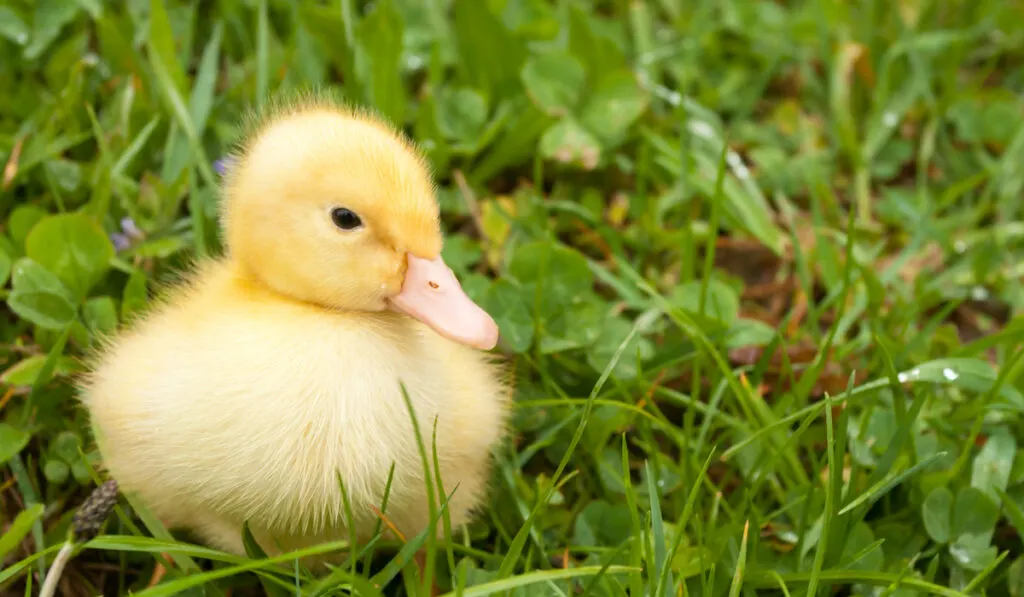
To successfully raise ducklings, you should know how to pick out the right duck breed for your farm, how to set up your brooder, and how to properly care for your ducklings as they grow into adulthood. To give your ducklings the best chance, you should learn everything you need to know about raising them.
Raising your own flock of ducks is a rewarding experience that can provide a source of food for your farm, if that is what you want. The key to successfully raising your own ducklings is to be as prepared as you can before you bring them home.
You should know what duck breed or breeds you want on your farm and you should get your brooder set up and ready beforehand if you can.
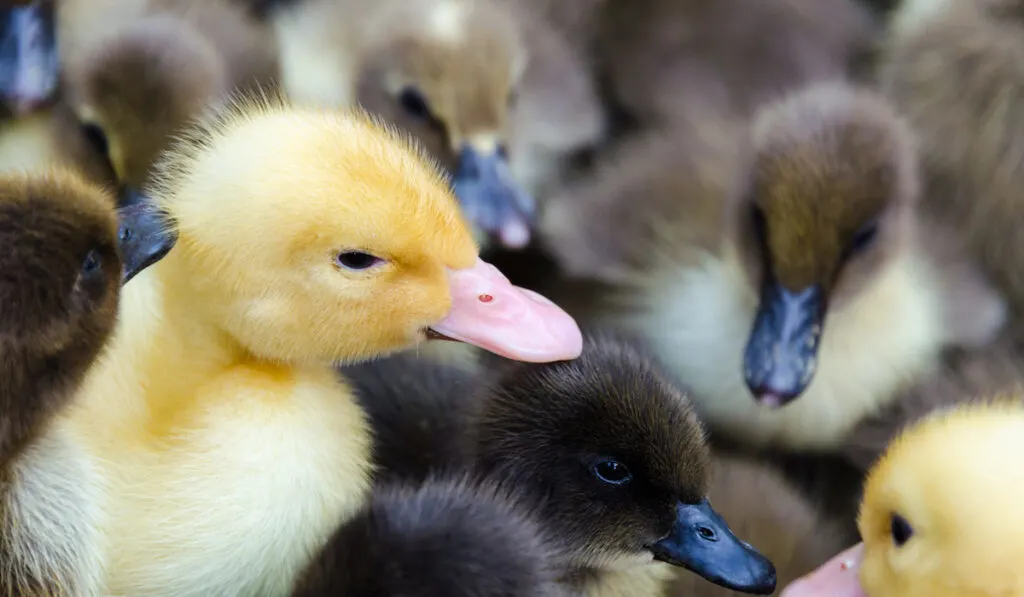
Table of Contents
Choosing the Right Duck Breed
Knowing the differences between the most common breed of ducks is important in determining which one is right for your backyard flock.
Do you want good egg layers? Do you want ducks that can fly? Do you intend on eating your farm-raised ducks one day? Here are some popular duck breeds for backyard farms and what they offer.
| Breed | Demeanor | Egg Production (annually) | Ability to Fly | Meat Production |
| Pekin | Very Friendly | 175 | Unable to Fly | Exceptional |
| Mallard | Friendly | 60-120 | Able to Fly Well | Suitable |
| Rouen | Very Friendly | 35-125 | Unable to Fly | Exceptional |
| Runner | Friendly | 150-200 | Unable to Fly | Suitable |
| Khaki Campbell | Less Friendly at First | 300+ | Can fly a little | Suitable |
Runner Ducks
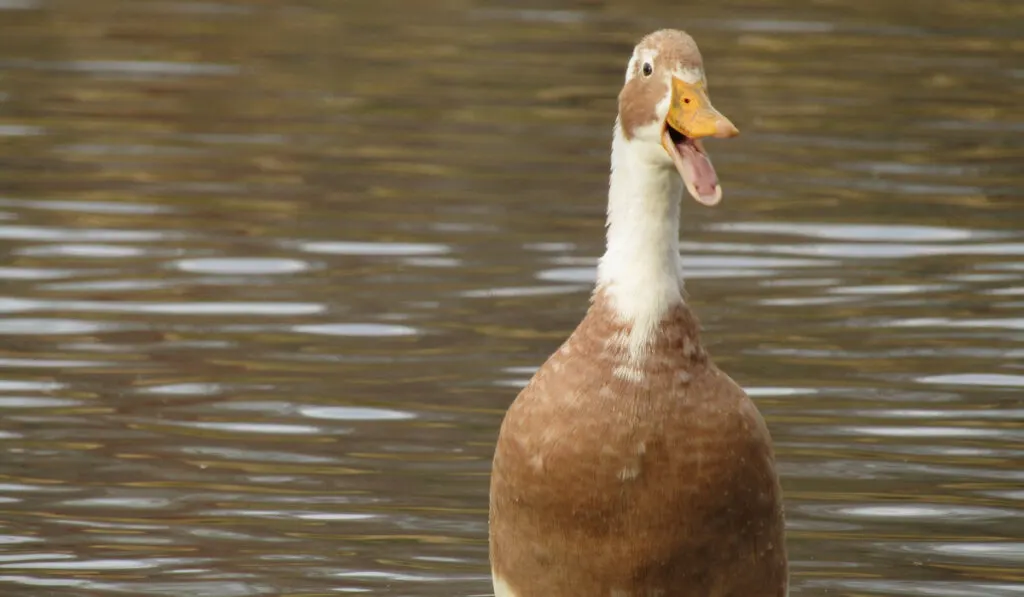
Runner ducks are great egg layers, producing between 150-200 eggs annually. They are well known as friendly ducks that stand and walk in an incredibly unique way.
They appear to stand upright when walking and because of this, they can walk extremely fast for a duck. They cannot fly, which makes them a great option for many farms.
Runner ducks will weigh around 3-5.5 pounds as adults and come in various colors.
Pekin Ducks

Pekin ducks make excellent pets because not only are they friendly, they also cannot fly! They lay an average of 175 eggs annually, so they would also be great choices if you intend on collecting eggs.
Pekin ducks are white, and they have yellow bills as well as yellow feet. These ducks can weigh up to 9 pounds as adults, making them one of the larger duck breeds discussed here.
Pekin ducks are also considered a good source of meat because of their size and build.
Mallard Ducks

Mallard ducks are a popular backyard-friendly duck breed, but it is important to know that they do fly so they may leave your property if they are not in a covered area.
They lay an acceptable amount of eggs annually, somewhere between 60-120 depending on the duck. They are louder than other breeds but are still very friendly.
They are small fowl, usually weighing about 2.5 pounds. Mallards have brown bodies with green-tinted heads.
Rouen Ducks
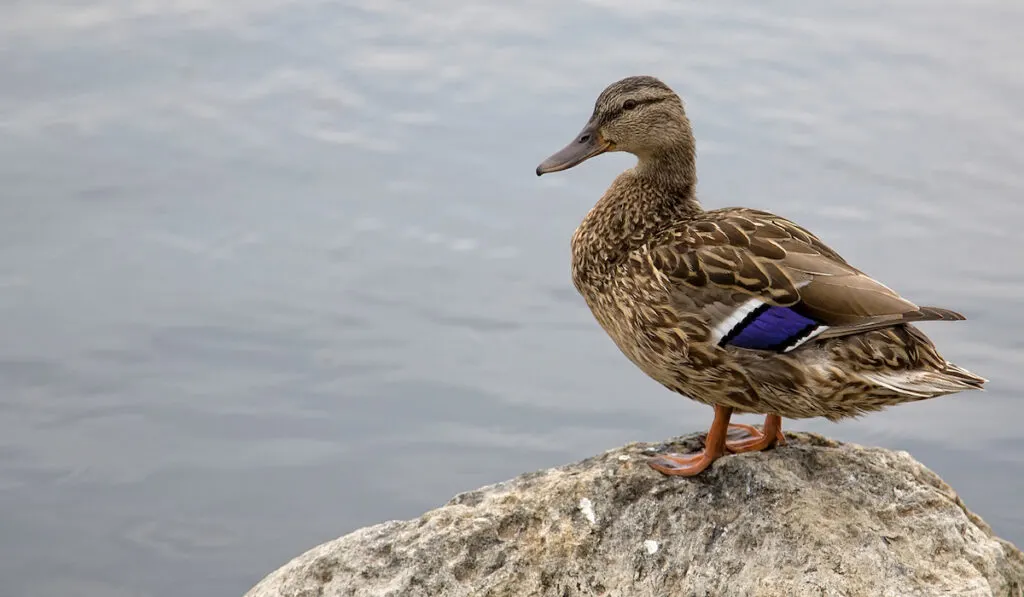
Rouen ducks make great farm pets as they are very friendly and unable to fly due to their larger weight. You do not have to worry about them flying off your property or out of their enclosure.
Rouen ducks typically weigh between 6-8 pounds and resemble Mallard ducks.
They are not excellent egg layers like other duck breeds, laying only 35-125 eggs yearly. Rouen ducks are also considered a good option for meat production.
Khaki Campbell
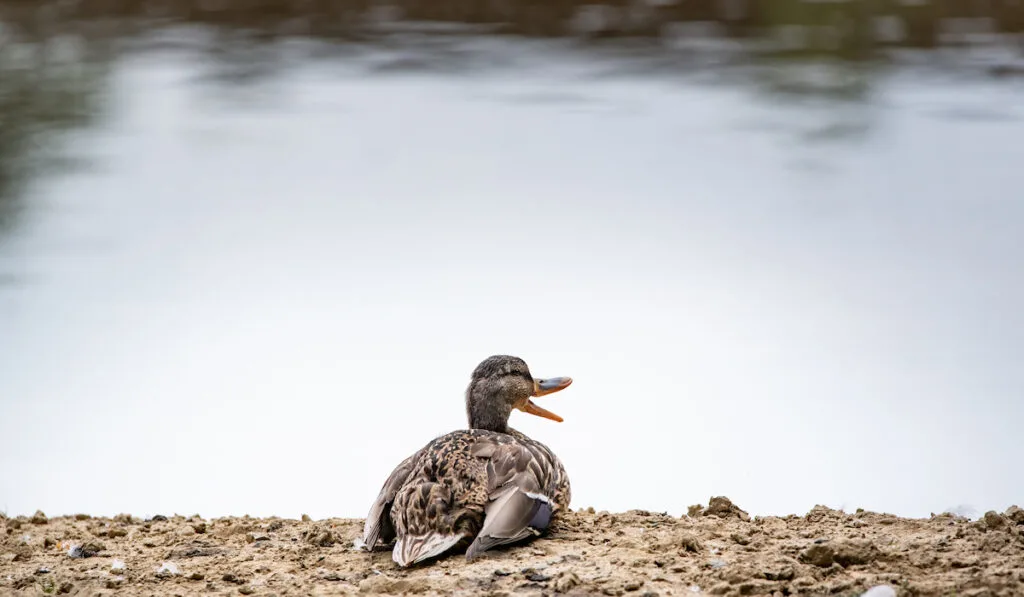
Khaki Campbell ducks tend to take a little more time to come around to people, but with a little work, they can make great pets. They are a mix between multiple duck breeds including the Rouen, Mallard and Runner breed.
Khaki Campbells are prolific egg layers, laying 300 or more eggs each year. They can fly a little, but not as much as Mallards.
Khaki Campbell ducks are relatively small, weighing between 3.5 and 5.5 pounds. They have green-tinted heads like their cousin, the Mallard, and they are light brown in color.
Where to Buy Ducklings
Finding ducklings is not as difficult as you may think. While you may have never noticed them before, there are probably ducklings available for sale somewhere near you. If not, the internet will solve that problem for you!

Local Farms
First, always try word of mouth with your farm friends. Someone you know probably knows of a local farm or individual who raises ducklings.
Sometimes you can find local farms by searching sites like Craigslist or Next Door. Local Facebook groups can also be a great resource to locate a local farm that offers ducklings.
Feed Stores
Many livestock feed stores sell ducklings in the spring and early summer. Near the end of March, you can contact local farm supply stores to find out when they will have ducklings ready to purchase.
They usually only have a limited supply and you may need to let them know beforehand if you plan to buy some ducklings, especially if you want a specific breed.
Alternatively, any feed store that sells chicks can usually special order some ducks the next time they place an order with the hatchery. They may want you to pay in advance for them but it never hurts to ask!
Order Online
If all else fails, you can order live day-old ducklings online and have them shipped to your local post office. You will usually be required to pick them up at a specific time at the post office closest to your address. There is typically a minimum order for ducklings when you order online.
- Murray McMurray Hatchery (this is my go-to)
- Meyer Hatchery
- Metzer Farms
- Cackle Hatchery

Brooder Setup for Ducklings
A brooder is the heated area where ducklings and chicks are raised until their feathers come in fully. It will keep them warm and safe from predators. If you can, try to get your brooder set up before you bring your ducklings home.
Location
Set up your brooder indoors or inside a temperature-controlled area, away from predators including domesticated cats and dogs. You can utilize a room in your house that is unused, like a spare bedroom or bathroom.
If you are unable to set it up in your house, try somewhere like an enclosed garage, barn, or other building on your property.
It needs to have adequate airflow and be safe from predators. You will also need an outlet to plug in your brooder lamp.
Brooder Box
You will essentially have to create your own brooder box, but it is usually much simpler than it sounds.
Basically, you need something that will contain the ducklings but is easy to clean and is open on top. Having an open-top allows you to more easily check the ducklings, feed them, provide a heat source, and change their bedding.
Raised Garden Bed Frames
While it may seem like a simple idea, using a raised garden bed frame can serve two purposes. It can house your ducklings temporarily and then actually serve a function in the yard once your ducks are old enough to be outside.
Here are two great options:
- Galvanized Oval (Stock Tank Look, no bottom)
- Galvanized Rectangle or Square (two sizes available)
I like the metal ones because they are easy to clean in between batches. The reality is once you raise your first set of ducks, you’ll probably go back for more!
Both of these could work for chicks too but they would need a cover. At only 12″ high chicks would easily hop up and out.
Stock Tank

If you prefer, you can use a stock tank as well. If you live on a farm, you may already have something lying around. It doesn’t need to be watertight so an old stock tank with holes would be perfect.
Even if you have to buy one new, stock tanks are great investments. I like this model on Amazon.com but they can also be easily found at your local feed store or even used online.
Kiddie Pool
Kiddie pools or pools designed for pets will work great as a duckling brooder. I like this one because it folds up nicely when you aren’t brooding and it comes in a variety of sizes depending on the number of ducklings you are raising.
It is easy to clean, open on top and can be used as an actual pool for your ducks when they are older. Kiddie pools are a relatively small investment and it can last for years as a duckling brooder or you can use it later as a pool for your fully grown, adult ducks.
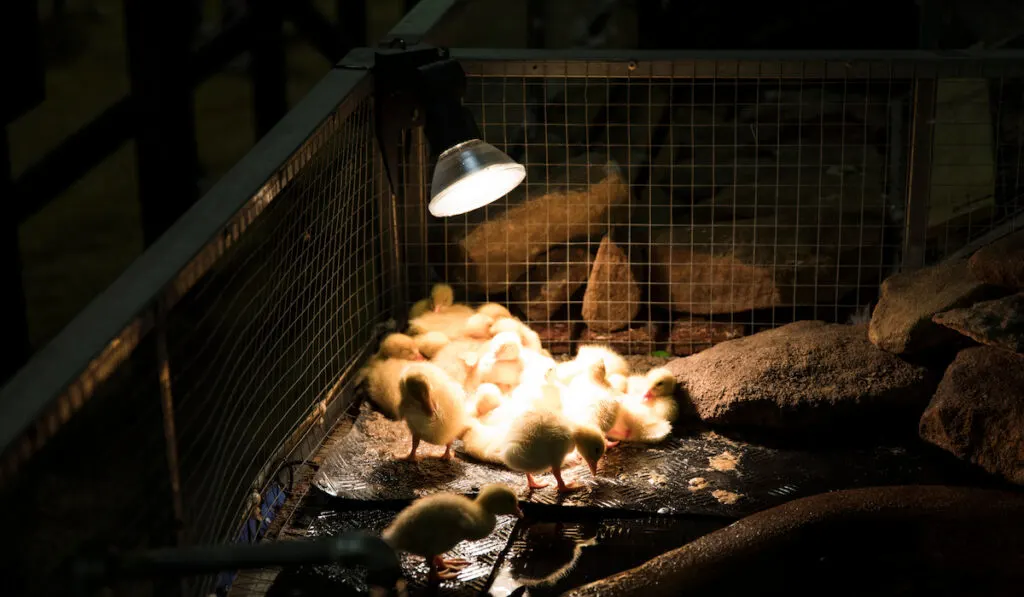
Heating Lamp
Ducklings are unable to regulate their own body temperature until they grow feathers, which does not happen until they are about 9 weeks old. In nature, the female duck that hatches the ducklings will keep them warm by allowing them to hide under her feathers.
To replicate this, you can position a heat lamp so that it points inside the brooder and helps keep your ducklings warm. Make sure the lamp is pointed to one half of the brooder, allowing the ducklings to leave the heat if needed.
This is the setup I use and it’s pretty inexpensive. Be sure and order two bulbs so that you always have a backup.
Just keep in mind that heat lamps do pose a fire danger. It is imperative that they be secured and not allowed to come into contact with anything potentially flammable.
I always use additional clamps, not just the one the lamp comes with.
I once had a cat knock into my brooder lamp and drop it on top of the bedding. I lost several chicks but thankfully avoided a fire. Better to be over cautious than to have a potentially deadly situation on hand.
Thermometer
A digital thermometer that attaches to the brooder will help to regulate the temperature inside your brooder. You can adjust the distance of your lamp depending on the temperature readings you get.
During the first week of their lives, ducklings need an environment with a 90-degree temperature. After that, you can lower their environmental temperature about one degree per day until it reaches 75 degrees.
At that point, as long as the temperature of their area does not go below 75 degrees, you can remove the heat lamp. This is optional but if you are worried about temperatures it can provide some peace of mind.

Bedding
You will need to have a bedding in your brooder that helps keep the ducklings clean and dry. Ducklings will poop and spill their water on the floor of the brooder.
Bedding will help absorb the excrement and water, keeping it from sticking to your ducklings. Stick with aspen or pine shavings, red cedar shavings are rumored to cause respiratory issues in some animals.
You can also use newspaper, old cloth pieces, or shredded pieces of paper as bedding. Bedding is cheapest if you get it at your local feed store.
Here are some options on Amazon but I highly recommend saving money and buying at the feed store if you can.
Waterer
Waterers made for baby chicks will work for ducklings, but they will spill and splash in the water. You can use a chick waterer if that is all you can find.
Consider investing in a single cup waterer as it will create less mess and is deep enough for the ducklings to easily get water without playing in it or spilling it everywhere.
- RentACoop Cup Waterer (best pick)
- Chick Waterer
Feeding and Nutrition
Ducklings should be fed a starter grower crumble feed that is designed specifically for ducks and other fowl. Crumble is small pieces of broken up feed that makes it easy for ducklings to eat.
Ducklings can safely eat chicken starter grower crumbles if you cannot find duckling feed. You can contact your local feed supply stores to see what they offer and what they can supply on special order.
You can switch from crumbles to a pellet or mixed grower feed at around 4 weeks of age. You should provide plenty of food for your ducklings at all times so they can eat whenever they are hungry, just make sure they have plenty of water available as well.
- Automatic Feeder (can also be a waterer)
- MannaPro Duckling Starter
- Purina Flock Starter Crumbles
Water
Ducklings should always have access to fresh water. It should be changed daily, as it can quickly get dirty.
Make sure it is not too deep, a duckling can drown easily before they are 4 weeks of age.
Ducklings need water to help them eat their food and they need to stay hydrated under their heat lamp. A dehydrated duckling can go downhill very quickly and sometimes cannot recover.
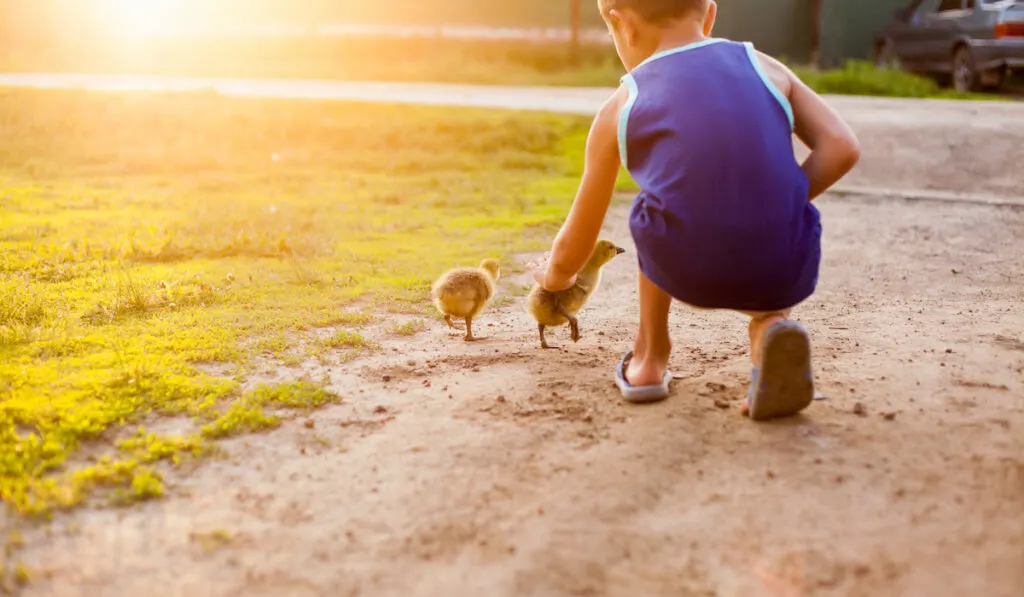
Transitioning Ducklings to Outside
Very young ducklings can be permitted to play outside under direct supervision only. At this stage they can get cold easily and are also easy prey for predators.
When your ducklings are at least 4 weeks, you can begin to transition them outside, as long as it is not too cold or hot. If the temperature outside does not go below 75 degrees, ducks can safely stay outdoors.
If it is significantly warmer outside, make sure they have lots of shade in their area, so they have somewhere to keep cool.
If temperatures are still fluctuating where you live, you can wait until they get all their feathers, to put them outside, usually at around 9 weeks old.
Once they are covered in feathers, ducks can maintain their body heat much easier and can withstand outdoor temperature changes.
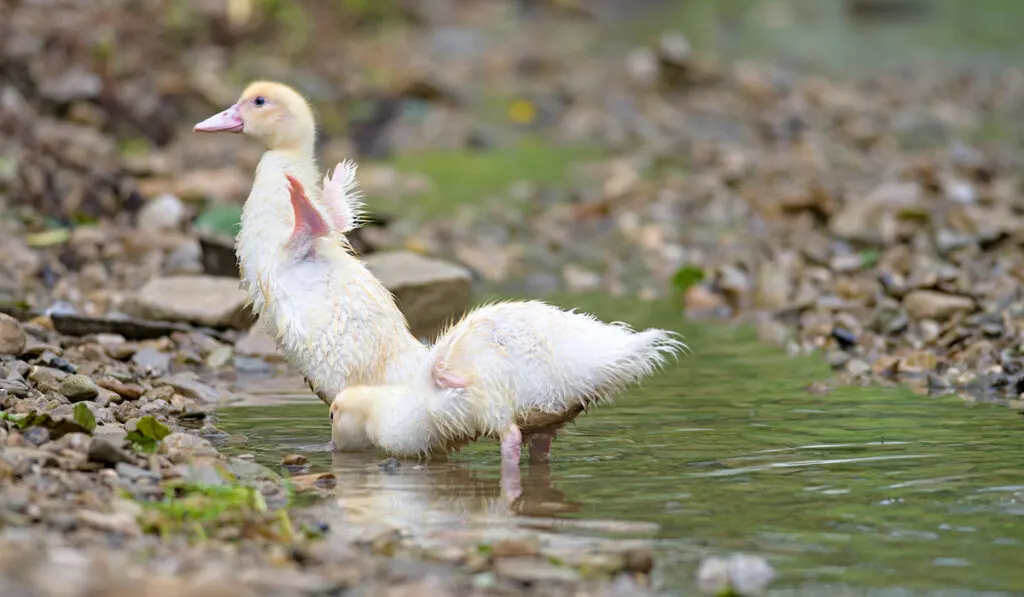
Important things to know
- Always make sure that your ducklings have access to water, especially if you have a heat lamp in their brooder. You do not want them to get dehydrated while they are in a 90-degree environment.
- Do not put a ‘pool’ in their brooder. Yes, ducks like to swim but ducklings less than 4 weeks of age cannot produce their own oils which makes them unable to swim! The oils that ducks produce allow them to make their feathers waterproof to prevent them from drowning. Wait until they are older and in their outdoor area to worry about a duck ‘pool’.
- Keep only ducklings of the same age together in a brooder. Never put ducklings of different ages in the same brooder. Larger ducklings can easily squash and even suffocate newly hatched ducklings when they huddle to sleep.
- Ducks need water to eat, so make sure if you provide food that you also provide water at the same time.
- If your ducklings are Mallards or another breed of duck that can fly, make sure their outdoor area is covered unless you are okay with them flying off.
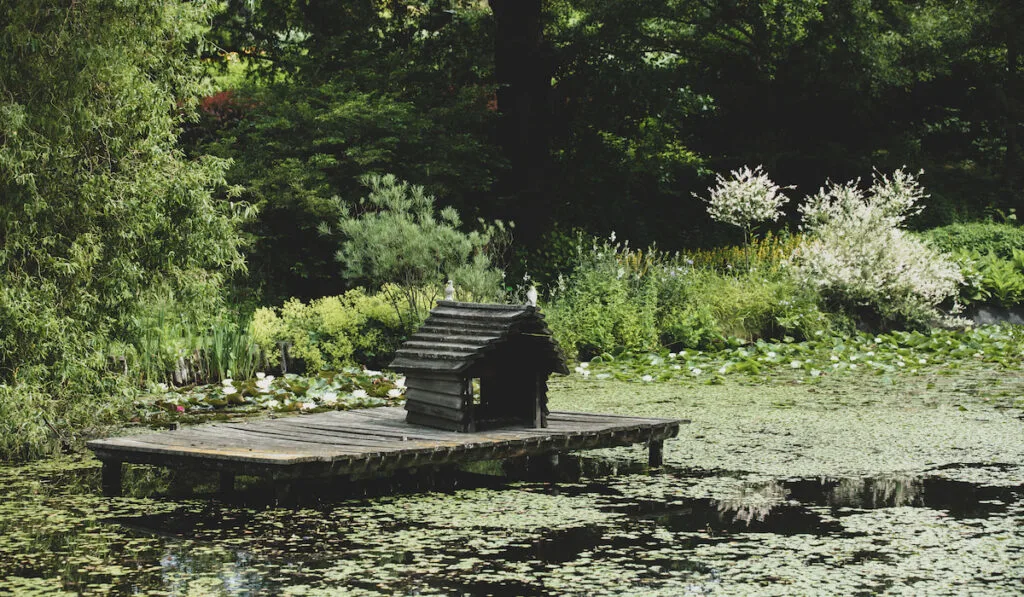
Outdoor Duck Area Setup
While your ducklings are still growing and living in the brooder, you should start getting their future outdoor home ready. Your duck area should include an enclosed shelter with a floor, bedding of some kind, and a fenced-in run.
Shelter
You can build a new enclosed duck house or convert something like a doghouse into one. It will need a roof, 4 walls and an open doorway so they can come and go easily.
Most ducks will not use nesting boxes and they will be content with simply bedding like pine shavings or straw. Ducks do not need roosting poles or multi-level coops since they do not roost at night like chickens do.
Instead, ducks will be happy with a comfy floor safe from predators and the outdoor elements.
If your ducks are housed with chickens, they will typically find a place to sleep on the floor of the coop.
If your ducks have their own area, a dog house, appropriately sized for the number of ducks you have, can make a great duck house.
- Two Support rails allows kennel take weight up to 154lbs. Removable Floor for easy cleaning, maintance and pest control. Roof that opens, with 2 locking arms.
- External dimensions of Norfolk Dog Kennel: 3 ft 10″ (W) x 2 ft 7″ (D) x 2 ft 8″ (H); Size of access door: 1 ft 3″ (W) x 1 ft 6″ (H)
- All panels are Insulated. Insulation consists of timber (tongue and groove) 0.47″, then 0.51″ of Styrofoam, then 0.08″ of plywood board. Keeps your dog warm in winter and cool in summer. Walls 150% thicker than other kennels.
I recommend something with an offset entrance like this one on Amazon.com. Keep in mind that if the dog house is elevated you may need to add a ramp as well.
Needed Supplies
You will need a large waterer and feeder to support your growing fowl into adulthood. You will also want to supply them with a pool of some sort if you can.
Make sure it is not too deep for their current size to prevent drowning. You will have to change the water regularly as they will dirty it up quickly.
Contrary to popular belief, ducks don’t HAVE to have a pool or water to swim in. They do enjoy it but it isn’t necessary to raising ducks. So if you don’t want to have a pool or don’t have the space for one, don’t let it deter you from owning ducks.

Outdoor Run
Surrounding their shelter, you will need a ‘run’ or open area that they can play and frolic in. If they can fly, make sure you cover the roof to keep your ducks from flying out of their enclosure. The more ducks in an enclosure, the more room your ducks will need.
Final Thoughts
Raising ducklings is a fun adventure that can be relatively easy if you are well prepared before getting your ducklings. Even if you bought your ducklings on impulse, you should be able to get your brooder together in no time!
While some of the journey will require a little trial and error, most of the difficulties of raising backyard ducklings can be avoided just by knowing what you have learned here. Good luck and have fun!
Resources
- https://en.wikipedia.org/wiki/Rouen_duck
- https://www.hgtv.com/outdoors/gardens/animals-and-wildlife/popular-duck-breeds
- https://www.meyerhatchery.com/productlist.a5w?subcat=1021&cat=1045
